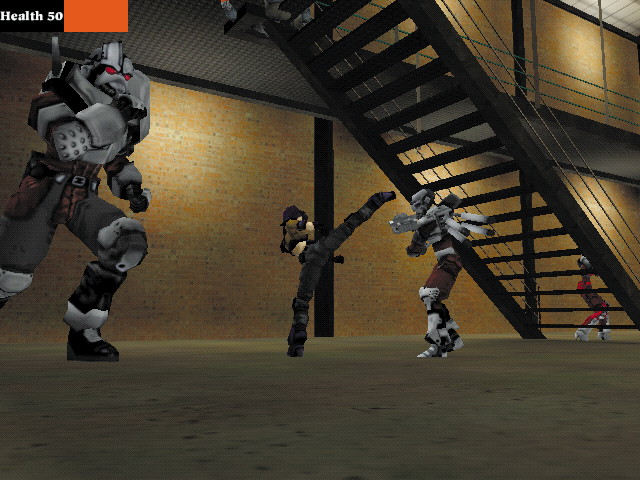Pre-beta features: Difference between revisions
m (link fix) |
(corrected and streamlined wording around Oni's VRAM requirement) |
||
| Line 73: | Line 73: | ||
==Rationale for cuts== | ==Rationale for cuts== | ||
When contemplating why various graphical effects below were removed, it's important to first look at the amount of VRAM on the early 3D graphics cards of the time. Computers made when Oni started development in 1997 were coming with 3D cards for the first time, and the VRAM on them ranged from 2 to 6 MB. Bungie West apparently anticipated continual growth in VRAM and they were aiming at that future point during development. As [[Alex Okita]] [https://web.archive.org/web/20170705124855/http://www.glixel.com/interviews/oni-bungies-classic-inspired-by-ghost-in-the-shell-w474297 later recalled], "we had one thing in mind when we were going into it, thinking that video cards would catch up. But then halfway through, Apple hands us this iMac, and our bar just sort of dropped on top of us. We're trying to figure out how we're going to get anything to run on it. They had this, I don't know – [[wp:IMac G3#Second generation|eight-megabyte video card]] or something? It was pretty miserable." VRAM would have been a particularly limiting factor in the use of lightmaps. By the time of Oni's release, the VRAM on 3D cards in new computers ranged from 8 to 64 MB (of course, most computer users did not own a brand-new or top of the line system). Thus, when it shipped, Oni [https://web.archive.org/web/20210116052716/http://halo.bungie.net/projects/oni/content.aspx?link=onifaq | When contemplating why various graphical effects below were removed, it's important to first look at the amount of VRAM on the early 3D graphics cards of the time. Computers made when Oni started development in 1997 were coming with 3D cards for the first time, and the VRAM on them ranged from 2 to 6 MB. Bungie West apparently anticipated continual growth in VRAM and they were aiming at that future point during development. As [[Alex Okita]] [https://web.archive.org/web/20170705124855/http://www.glixel.com/interviews/oni-bungies-classic-inspired-by-ghost-in-the-shell-w474297 later recalled], "we had one thing in mind when we were going into it, thinking that video cards would catch up. But then halfway through, Apple hands us this iMac, and our bar just sort of dropped on top of us. We're trying to figure out how we're going to get anything to run on it. They had this, I don't know – [[wp:IMac G3#Second generation|eight-megabyte video card]] or something? It was pretty miserable." VRAM would have been a particularly limiting factor in the use of lightmaps. By the time of Oni's release, the VRAM on 3D cards in new computers ranged from 8 to 64 MB (of course, most computer users did not own a brand-new or top of the line system). Thus, when it shipped, Oni required a mere 4 MB of VRAM.<ref>This is inferred from [https://web.archive.org/web/20210116052716/http://halo.bungie.net/projects/oni/content.aspx?link=onifaq Bungie's Oni FAQ] which lists the ATI Rage Pro as a supported card. The Rage Pro came with as little as 4 MB of memory. Stefan Sinclair's [https://web.archive.org/web/20010429035130/http://www.doomhammer.com/Oni/ personal Oni help page] and Dave Dunn's [http://web.archive.org/web/20000824155730/http://www.insidemacgames.com/features/00/dunn/p3.shtml August 2000 interview] also claimed that the game would run in 4 MB of VRAM. However it's difficult to find any reports from users who ran Oni on such a graphics card. There were reports of running it on 6 MB cards, e.g. [http://carnage.bungie.org/oniforum/oni.forum.pl?read=9318 "Re: What do you Mac users have?"], [http://carnage.bungie.org/oniforum/oni.forum.pl?read=18458 "Re: Oni runs really slow"]. Oddly, the [[:Image:Windows (US) box art (holographic) - bottom.jpg|U.S. Windows box]] says "2MB", which is exceedingly unlikely to be correct. The [[:Image:Windows (CA) box art - back.jpg|Canadian box]] (and probably others) stated "4MB".</ref> | ||
The PlayStation 2 was [[wp:PlayStation 2 technical specifications#System memory|even more limited]] than most computers, with 32 MB of main system RAM and 4 MB of VRAM. Bungie West never blamed the PS2 port, which was performed by an outside studio, for any changes to Oni's features or release date, but considering the simultaneous release of the Windows, Mac and PS2 versions, and the [[Oni (PlayStation 2)#Visual differences|small cuts]] made to content in the PS2 version on account of limited RAM, as well as Take-Two's emphasis on the PS2 version in their advertising, it's possible that there was (at best) a lack of interest on Take-Two's part in adding niceties to the PC versions which PlayStation owners would not be able to experience. Likewise, multiplayer was not a common part of the PS2 gaming experience in 2001 (the Network Adaptor being an optional attachment), so it might not have seemed worthwhile to extend development just to make multiplayer happen. | The PlayStation 2 was [[wp:PlayStation 2 technical specifications#System memory|even more limited]] than most computers, with 32 MB of main system RAM and 4 MB of VRAM. Bungie West never blamed the PS2 port, which was performed by an outside studio, for any changes to Oni's features or release date, but considering the simultaneous release of the Windows, Mac and PS2 versions, and the [[Oni (PlayStation 2)#Visual differences|small cuts]] made to content in the PS2 version on account of limited RAM, as well as Take-Two's emphasis on the PS2 version in their advertising, it's possible that there was (at best) a lack of interest on Take-Two's part in adding niceties to the PC versions which PlayStation owners would not be able to experience. Likewise, multiplayer was not a common part of the PS2 gaming experience in 2001 (the Network Adaptor being an optional attachment), so it might not have seemed worthwhile to extend development just to make multiplayer happen. | ||
Revision as of 19:33, 28 March 2025
- This article is about changes in the game engine during development. To learn about changes made to the levels and other game assets, see the Pre-beta content page.
Below we discuss features that were cut from Oni before release. The focus is on features for which we have documentary evidence (screenshots, video), not features that were only teased in interviews – however those teased features are collected in the final section.
Multiplayer
See the Multiplayer article to learn all about the most infamous missing feature from Oni.
Blood, shadows, and bullet marks
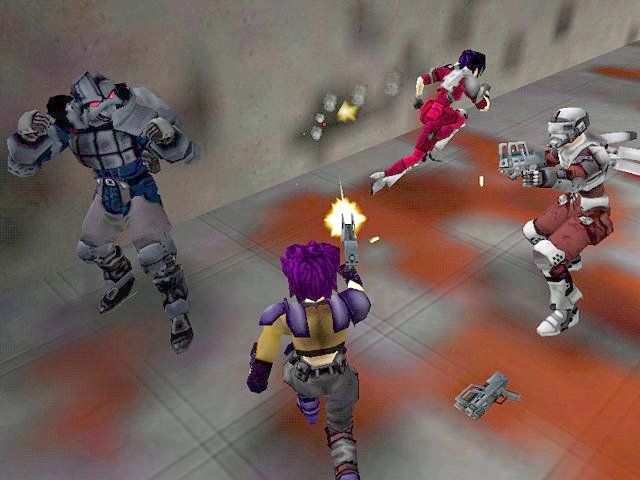
| |
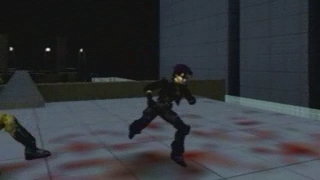
|
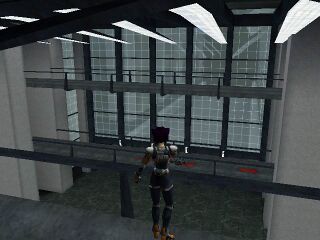
|

|
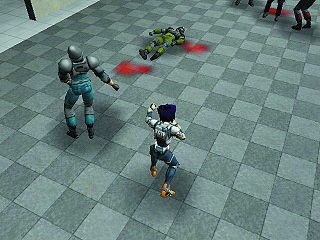
|
These real-time stencil effects could build in intensity, as seen in image 1 where the burn effects are darker where Konoko continues to shoot the wall. The blood in images 1 and 2 also seems "thicker" in some places. The appearance of blood changed a fair amount over time, sometimes appearing fainter as in image 2 or sharper-edged and brighter in color, as seen in image 3.
One can see the system in motion at 0:53 in the 1999 trailer where Konoko's shadow appears as she lands, and morphs along with her movements; as she shoots an enemy, small droplets of blood can be seen spraying onto the floor. Konoko's shadow on the catwalk is also real-time at 1:14. An extended shot at 1:40 shows the shadows generated by Konoko and her ninja opponent.
The resolution of these dynamic shading effects was quite low, so possibly Bungie West was dissatisfied with their appearance. The system also seemed to have trouble crossing polygon boundaries, as seen on the floors in images 4 and 5, and elsewhere. By the E3 of May 2000, blood had been removed from publicly demoed builds. Matt Soell said that this was in order to re-work the effect: "Along with the marks left by bullets, blood will look much better than it used to." Bungie eventually settled for using a premade round texture for character shadows and premade stencil textures for the various weapons' impact effects. The blood effect was totally removed.
The explanation for the cutting of blood was not technical limitations but rather that it interfered with the hit flashes that players needed as cues in a melee fight, and also to avoid a Mature rating from the ESRB (and equivalent boards outside North America). Animated blood would have required an "M" rating, which would limit the number of younger players who were allowed to buy or play the game. This was the first time that Bungie shied away from putting blood in their games, and the Marathon and Myth games had received "M" ratings, so this was a controversial decision among some fans. It's possible that Oni's new owners, Take-Two Interactive, had a different philosophy on realistic violence vs. marketability.
Lightmapping
Oni was originally intended to have detailed lighting produced through radiosity, as mentioned in Oni's positioning statement. An outside program would be used to pre-calculate detailed lighting solutions which Bungie West would then export as lightmap textures. These textures would be displayed on surfaces in-game via OpenGL multitexturing. The smoothly-shaded spotlights you see on these walls could not be accomplished through the engine's current vertex-coloring approach to shading (not without subdividing the walls into a ridiculous number of vertices).
| 1999 | 2001 |
|---|---|
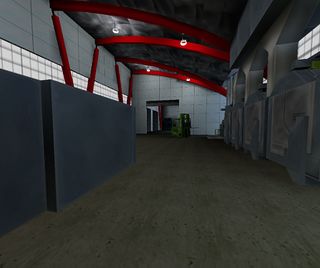
|
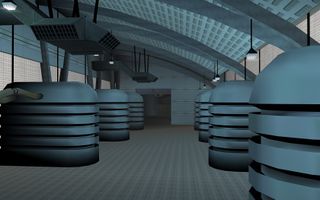
|
| (click images to enlarge) | |
Here's a before/after from Musashi Manufacturing. In the original version of this area, the lights actually do something. The light and shadow give a greater sense of volume to the space.
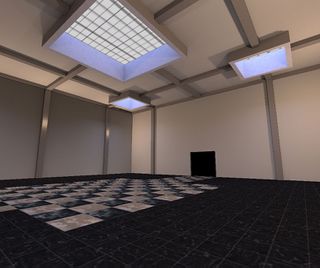
|
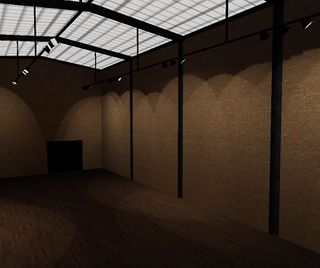
|
| (click images to enlarge) | |
These are a couple tests that were probably rendered in-game. It may be hard to believe that this imagery came from Oni's engine, but the jaggies on the polygons mean that it is unlikely to be a product of the 3D Studio Max renderer like this anti-aliased rendering, and if one looks closely, blockiness is evident in some shadows due to the limited resolution of lightmaps. Up close this would be much more noticeable, as in this image (note the shadow on the pipe leading down to the tank).
| 1999 | 2001 |
|---|---|
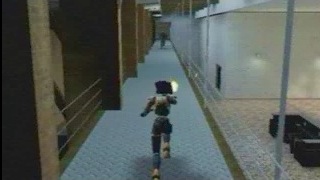
|
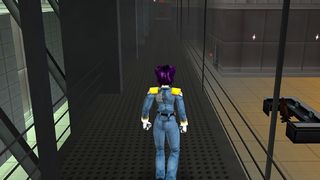
|
Perhaps one of the most striking before/after shots illustrating the effect that lightmapping could have had on the game is found in the Musashi lobby. The wall in the lobby area down to Konoko's right used to have illumination from two point lights on the wall, and what appears to be dappled light filtering through the glass windows at the entrance. Now we simply have box models for light fixtures with lens flare sprites slapped on top of them, and no light being cast on the wall.
This is because, in the final game, lightmap textures were replaced by vertex coloring. The values for the colors were apparently still based on the calculated radiosity solutions, going from this post by Chris Butcher. However, because vertex coloring can only have as much detail as the number of polygons making up the environment, the lighting is far cruder. Even the vertex coloring doesn't seem to be used to the fullest extent possible, and the shadows it produces sometimes seem illogical or inaccurate.
Rigid body physics
Rigid body physics, more often referred to by fans using simpler terms such as "kickable chairs" or "movable furniture", was promised for much of Oni's development, but all furniture in the game is now static. Modders have uncovered the fact that there is code present in Oni for movable objects, but the collision is unpolished. Watch Konoko play with spheres and cubes. You'll notice that all movable objects are treated as spheres by the collision code.
Inverse kinematics
Inverse kinematics, also promised in Oni's positioning statement, was planned in order to allow complex melee interactions including "smash[ing] your opponent’s head into a nearby wall". It was removed when Bungie West found that IK wasn't necessary for performing throws and disarm moves, as explained by Bungie spokesman Matt Soell here. Environmental interaction such as damaging enemies with wall impacts was never implemented.
Rationale for cuts
When contemplating why various graphical effects below were removed, it's important to first look at the amount of VRAM on the early 3D graphics cards of the time. Computers made when Oni started development in 1997 were coming with 3D cards for the first time, and the VRAM on them ranged from 2 to 6 MB. Bungie West apparently anticipated continual growth in VRAM and they were aiming at that future point during development. As Alex Okita later recalled, "we had one thing in mind when we were going into it, thinking that video cards would catch up. But then halfway through, Apple hands us this iMac, and our bar just sort of dropped on top of us. We're trying to figure out how we're going to get anything to run on it. They had this, I don't know – eight-megabyte video card or something? It was pretty miserable." VRAM would have been a particularly limiting factor in the use of lightmaps. By the time of Oni's release, the VRAM on 3D cards in new computers ranged from 8 to 64 MB (of course, most computer users did not own a brand-new or top of the line system). Thus, when it shipped, Oni required a mere 4 MB of VRAM.[1]
The PlayStation 2 was even more limited than most computers, with 32 MB of main system RAM and 4 MB of VRAM. Bungie West never blamed the PS2 port, which was performed by an outside studio, for any changes to Oni's features or release date, but considering the simultaneous release of the Windows, Mac and PS2 versions, and the small cuts made to content in the PS2 version on account of limited RAM, as well as Take-Two's emphasis on the PS2 version in their advertising, it's possible that there was (at best) a lack of interest on Take-Two's part in adding niceties to the PC versions which PlayStation owners would not be able to experience. Likewise, multiplayer was not a common part of the PS2 gaming experience in 2001 (the Network Adaptor being an optional attachment), so it might not have seemed worthwhile to extend development just to make multiplayer happen.
An anecdotal report here from a forum member indicates that Bungie may have had frame rate troubles as well with earlier builds of the game. Even watching the 1999 trailer, one can see segments which seem to be running as low as 10 frames per second. Hardy LeBel, the Design Lead, commented on Oni Central Forum that they had issues with performance due to the use of glass in some areas (see Pre-beta content § Decline in appearance for quotes). If simple glass was causing frame rate issues, we could imagine that performance would have been a huge problem with some of the fancier features above. Even after further optimization, the final game faced complaints from some players about low frame rates even when they played on high-end systems (mainly Macs[2]).
Apart from all the above issues, we should keep in mind that Oni was rushed to completion because of the Microsoft acquisition, which happened three years into Oni's development in June of 2000. All staff were going to have to move to Redmond, Washington and contribute to Halo so it could be an Xbox launch title. In the limited time remaining to them, the Bungie West staff put in massive crunch time in order to complete and polish as much of the game as they could, but difficult decisions had to be made, such as cutting multiplayer and the unfinished BGI level. Even if Take-Two had decided that they wanted to extend Oni's development by another six months in order to polish the game, the question would be "With what staff?" All Bungie West staff had quit or merged with Bungie HQ in Redmond by the end of 2000. The entire game would have needed to be handed off to a new team that was totally unfamiliar with the engine. Keeping this timeline in mind, we could explain many cuts to the game as simply the result of rushed development without even needing to point to technical limitations in computers of the day.
- ↑ This is inferred from Bungie's Oni FAQ which lists the ATI Rage Pro as a supported card. The Rage Pro came with as little as 4 MB of memory. Stefan Sinclair's personal Oni help page and Dave Dunn's August 2000 interview also claimed that the game would run in 4 MB of VRAM. However it's difficult to find any reports from users who ran Oni on such a graphics card. There were reports of running it on 6 MB cards, e.g. "Re: What do you Mac users have?", "Re: Oni runs really slow". Oddly, the U.S. Windows box says "2MB", which is exceedingly unlikely to be correct. The Canadian box (and probably others) stated "4MB".
- ↑ This player considered it acceptable to drop below 5 fps in large areas on his high-end Mac from 1998, and Michael Eilers in his IGN review identified the Mac as getting the short end of the stick performance-wise, as his top of the line 500 MHz G4 with 32 MB VRAM frequently got sub-20 fps.
Hypothetical but unseen
A brief list of features that were promised, but which we have no visual evidence for:
- The infamous "neural net" AI. The AI was originally planned to be able to:
- experience wariness and fear,
- call for backup when outmatched,
- fight as a group,
- move objects to block your path,
- take cover when under fire, even behind furniture and moving objects,
- follow you by using elevators,
- and generally demonstrate emergent behavior.
- This much-hyped feature was claimed to have been working in the office, and described in detail by an IMG reporter in this preview. But after the first AI programmer was fired, the feature seemingly evaporated and the programmer was blamed for promising too much. Interestingly, the AIs in the final game normally run blindly into your gunfire, but a patch by a fan restored their ability to take cover intelligently. It turned out that the ability was present all along but obscured by a simple blunder in the code. Was this the result of the second AI programmer lacking familiarity with the code written by his predecessor? How much other working code was lost in the migration from "AI" to "AI2" code after the first programmer supposedly "couldn't deliver on" her promises? It's worth noting that the term "neural net" was used by Pease and Zartman, not the programmer herself (see above sources).
- Movable furniture. Konoko would be able to throw a chair at an oncoming enemy or push over a bookcase to block a pursuer. As mentioned above, the AI would also be able to do these sorts of things.
- The initial press release from 1998: "If the action gets too hairy, kill the lights, prime a concussion grenade and dive through a window while the room explodes above you." Oni, of course, has no grenades, and you can't dive through (intact) windows or turn off lights.
- Bungie's internal positioning statement, not released to the public, mentions "destructible environments". It's doubtful that this feature was actually worked on besides allowing doors to be broken down, which was a canceled feature that both Konoko and enemy AIs would be able to utilize.
- There was a hope early on that the particle system would allow for water physics, as mentioned in this sneak preview. This was in fact worked on by Bungie West to some extent but canceled at an unknown point in development.
- Particles were also expected to be able to cast light on nearby surfaces, but this did not pan out. A related point is the removal of light source data from the final game because the graphics engine could not make use of in-world light sources.
